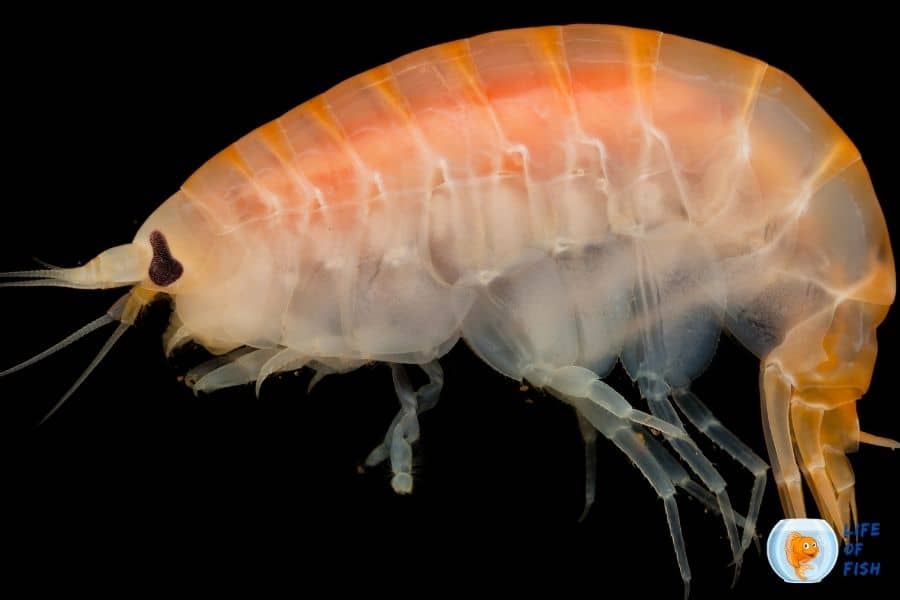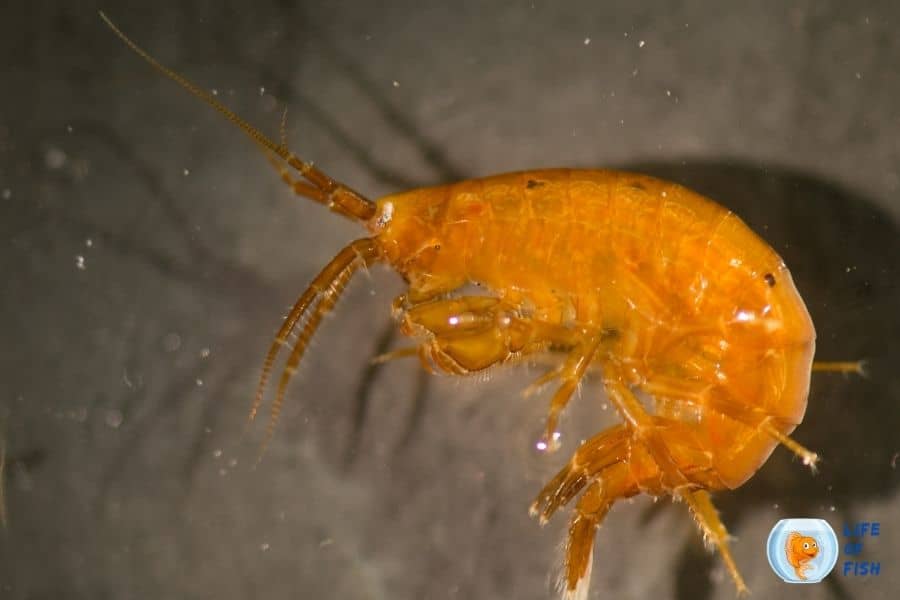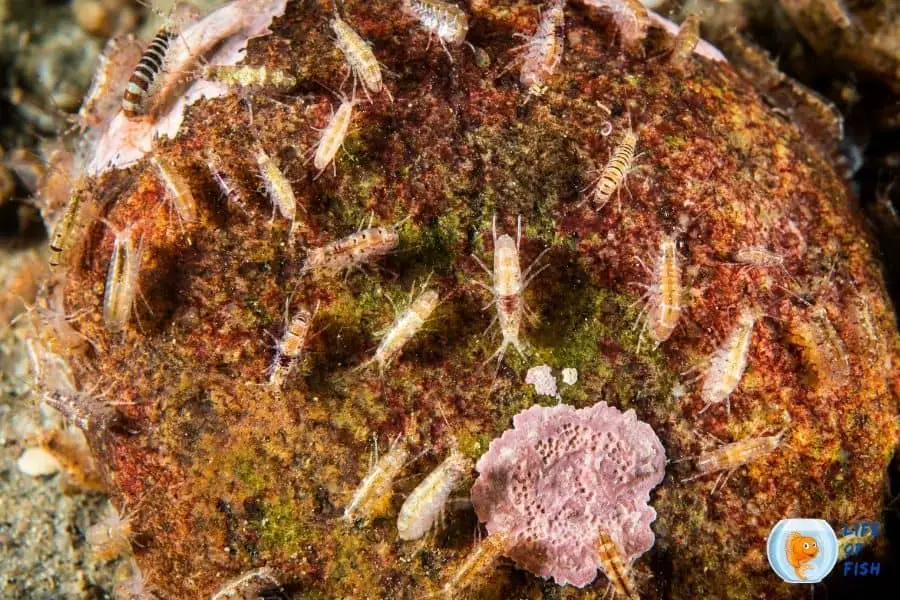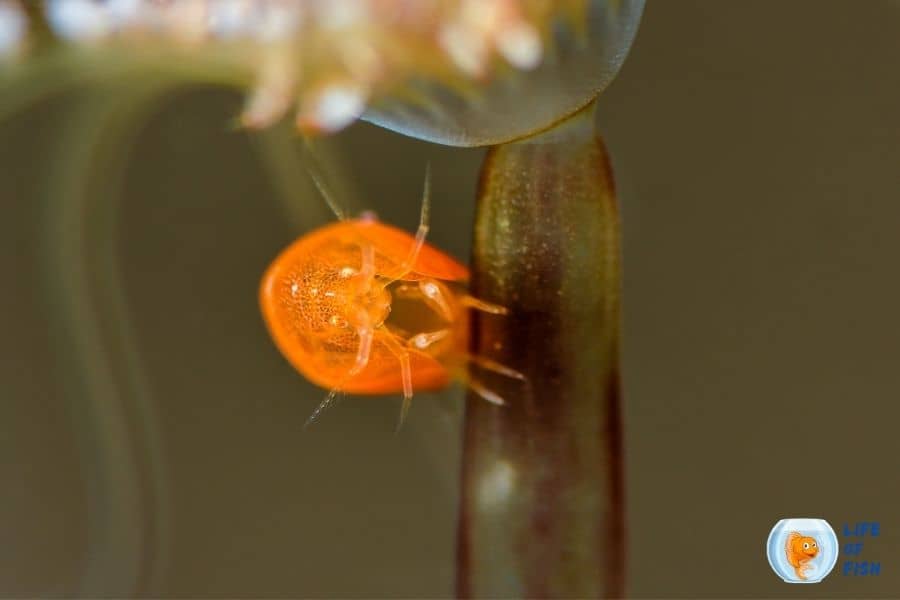Although amphipods growth is beneficial for your saltwater aquarium, seeing amphipods in your aquarium is an eyesore. However, these ugly-looking little creatures are a great natural food source for your saltwater fish, and they help you get rid of algae problems in your aquarium.

But, the problem is, you know, they are ugly. And we don’t want to make our precious aquarium awful just because of those crustaceans. so What Eats Amphipods?
So, let’s learn about how to get rid of amphipods in this article.
What Eats Amphipods?
Jump To
Almost any fish eats amphipods as they are zooplankton. However, problems arise as amphipods are active only at night. In the daytime, they hide behind the decorations, rocks, etc.
This behavior makes it more challenging for predator fish to catch amphipods because most predator fish hunt only in the daytime.
So, you need to pick some fish that seek food in the day and at night.
What Are Amphipods?
Amphipods, also known as Amphipoda, are microscopic crustaceans with no carapace and generally compressed bodies. They come in various bright colors; red, pink, yellow, green, and blue.
These tiny creatures mostly resemble shrimps but have a compressed body from side to side. There are more than 9900 amphipod species discovered so far.
They range from one millimeter to 340milimetres in length. (0.039 to 13 in) These tiny creatures are mostly detritivores or scavengers and are mostly live in marine environments.

Many sea animals like fish and birds eat amphipods for their survival; hence these creatures stay hidden most of the time.
They are not harmful creatures, and they are good at controlling brown algae. Many aquarists openly welcome these little creatures in their aquariums because they make a nice additional food source for the fish.
Still, sometimes overpopulation of amphipods can be a nuisance for aesthetic reasons. lets see in more details What Eats Amphipods?
Do Amphipods Eat Coral?
Yes. Some amphipod species eat coral. However, they are mostly active at night, so you may not see them eating corals at night.
Given that, not all amphipods eat corals. There are some innocent amphipod species that only feed on algae.
So, better check them at night with a flashlight to see if amphipods eat corals at night. Usually, coral-eating amphipods are large.

Where Do Amphipods Live?
Amphipods inhibit all parts of the sea, rivers, sand beaches, lakes, caves, and moist and warm habitats on many tropical islands.
Marine amphipods live even in the deep sea under depths of more than 9,100 m. Therefore, it is hard to eliminate creatures if bred in captivity. However, you can control amphipods by introducing amphipod predators in your aquarium.
Amphipods Predators (What Eats Amphipods?)
Having amphipod predators does not eliminate the amphipod population in your aquarium. However, these predator fish will help you control the population to a minimum level.
If you want to get rid of amphipods, there are other solutions, which we will talk about later in this article. But those solutions have some drawbacks with them which we should warn you about.
So, you better off with these amphipod predators to keep your aquarium under control. It’s better to know that a small quantity of amphipods doesn’t harm your aquarium anyway.

Wrasse
Wrasses are marine fishes of the Labridae family. There are more than 600 Wrasse species that live in the sea. These brightly colored fish species are typically small, and most of them are less than 20 cm (7.9 in) long.
However, the largest wrasse species, the humphead wrasse, can grow up to 2.5 m (8.2 ft) long. These fish are efficient carnivores that mainly feed on a wide range of small invertebrates.
So, if you want to get rid of amphipods, Wrasses are your best bet. Keep several wrasse fish in your aquarium, and they will take care of the rest.
Mandarins
Mandarin Dragonet, also known as Mandarin Goby or Mandarinfish, is one of the most beautiful saltwater fish you can keep in your aquarium.
These small bright-colored fish are hardy, disease-resistant, and inexpensive fish species that are suitable for beginners. They grow about 4 inches at most and feed on small crustaceans such as copepods and amphipods.
They are generally peaceful fish species and an excellent choice for your amphipods issue. As Mandarine’s only source of food is pods, they will happily eat all of your amphipods in your aquarium.
However, if you intend to keep these fish in your aquarium, you will have to provide pods constantly as Mandarins do not feed on other fish food.
Clownfish
Clownfish or Nemo, as you know them, are one of the most recognizable saltwater fish species. These fish are also known as anemonefish because they tend to live in Anemones.
Clownfish reach about 4.3 inches in length and are available in various colors and patterns. They are omnivore species that mainly feed on zooplankton from the water column, such as copepods and amphipods.
You can keep clownfish to reduce the amphipods population, but they are not good at eliminating amphipods. The reason for this is amphipods hide in the daytime, and clownfish only prey in the daytime.
Clownfish sleep at night, which leaves amphipods to have a chance to survive in your aquarium.
Pipefish
Pipefish are a subfamily of a small fish family, Syngnathidae. They look like straight-bodied seahorses and grows for about 14-15.5 inches long.
Pipefish generally live in sheltered areas in coral reefs or seagrass beds. They are relatively hardy fish that can adjust well in aquarium life in ideal water conditions, but you should keep them only with seahorses because of their poor swimming ability.
Pipefish feed on live foods such as brine shrimp, small ghost shrimp, copepods, and amphipods. If you have a reef aquarium with no other fish, these species might be an excellent choice to get rid of amphipods in your aquarium.
Sea Horses
Sea horse is a small marine fish that belongs to the Syngnathidae family in the genus Hippocampus. As the name suggests, sea horses have a horse-like face and grow about 1.5 to 35.5 cm long.
These are relatively hard to keep saltwater fish species. However, captive-bred seahorses can hold for longer in aquariums. They are carnivore species that mainly eat frozen or freeze-dried Mysis shrimp in captivity.
But, amphipods are an essential source of live nutrition for seahorses. Sea horses will happily eat amphipods for you, but keep in mind that they need intermediate-level care in your aquarium.
How Do I Get Rid Of Amphipods?
As we have already explained above, one way to get rid of amphipods is to introduce amphipod predators like Wrasse, mandarin fish, clownfish, pipefish, and seahorses.
The fish we mentioned are some of the best amphipod eaters. Therefore, they will help you keep your amphipod population under control.
But, what if you have a large population of amphipods and want to get rid of all of them?
Well. There are some proven treatments for this. However, these treatments should be done carefully.
Interceptor Treatment
Interceptor is a deworming medicine made for dogs. It contains milbemycin oxime and is a proven method to get rid of red bug infestation in corals.
This treatment will also kill shrimps, pods, and crabs. So, we can use Interceptor to get rid of amphipods in our aquarium. The recommended dosage is a 25-mg aliquot of Interceptor per 10 gallons of water.
You should dissolve the tablet in water completely to make it work. However, you MUST remove any shrimps or crabs you want to keep in your aquarium before treating your tank with an Interceptor.
This medicine will not harm any other aquarium life other than shrimps, crabs, and pods.
Tip: If you don’t find an Interceptor, you can buy an alternative product with milbemycin oxime. One such recommended product is Dr. G’s SPS & LPS Coral Dip Solution.
Freshwater Dip
Some aquarists had success with this method, and it is safe for your aquarium life. You have to dip everything in your aquarium in freshwater, including live rock and live sand.
First, remove your fish and other species into another container, remove water, and then take decorations, corals, and everything else one by one and dip them in freshwater.
Marine amphipods die in freshwater, but good bacteria survive. So, there’s nothing to be afraid of. Although this is time-consuming work, this method ensures that all your aquarium life survives after this treatment.
H2O2 (Hydrogen peroxide) Dip
Instead of freshwater, you can use hydrogen peroxide solution to make sure that amphipods die. First, dip everything in your aquarium in a 1:10 concentration of 3% H2O2.
Next, completely remove the sand bed and replace the water. Then rinse the tank with H2O2. Hydrogen peroxide H2O2 will kill algae, amphipods, and copepods but will not harm plants, fish, and inverts.
Read: Fairy Shrimp Vs. Brine Shrimp: Everything Need To Know
Read: Get Rid of Red Worms (Camallanus Worm)
Do Amphipods Eat Copepods?
Yes. Amphipods are larger than copepods so they can prey on copepods. In a tank environment, only one pod creature will dominate. As in this case, amphipods dominate because they are much bigger than copepods.
Conclusion on What Eats Amphipods
Amphipods are annoying creatures that colonize fast and eat coral and copepods. While they don’t harm your fish, their disgusting look makes your tank unpleasant. Because of that, many aquarists prefer to get rid of amphipods.
You can control the amphipod population with amphipod predators listed above. Further, you can eliminate amphipod infestation with Interceptor treatment, Freshwater dip, and H2O2 treatment discussed above. Now you know everything on What Eats Amphipods
Read: Palythoa Care | Must Know Points | Tank Size, Water Quality, Feeding
Read: Moon Jellyfish Care Guide | Everything To Know | Exotic Pets
